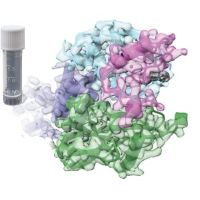Specification
| Description | Recombinant protein from the full-length sequence of Homo sapiens ETS homologous factor (EHF), transcript variant 2 (NM_012153). |
| Organism | Homo sapiens (Human) |
| Expression Host | Human Cells |
| Tag Info | His or DYKDDDDK. Please contact us if you need further information or require specific designed tag. |
| Purity | Greater than 90% by SDS-PAGE gel |
| Uniprot ID | Q9NZC4 |
| Entry Name | EHF_HUMAN |
| Gene Names | EHF ESE3 ESE3B ESEJ |
| Alternative Gene Names | ESE3 ESE3B ESEJ |
| Alternative Protein Names | ETS homologous factor (hEHF) (ETS domain-containing transcription factor) (Epithelium-specific Ets transcription factor 3) (ESE-3) |
| Application | Antigens, Western, ELISA and other in vitro binding or in vivo functional assays, and protein-protein interaction studies; For research & development use only! |
| Buffer | Purified protein formulated in a sterile solution of PBS buffer, pH7.2, without any preservatives |
| Endotoxin | Endotoxin level is < 0.1 ng/µg of protein (<1EU /µg) |
| Length | 300 |
| Molecular Weight(Da) | 34892 |
| Protein Sequence | (The sequence of expressed protein may have some variation from the sequence shown below. Please contact us for the exact sequence.) MILEGGGVMNLNPGNNLLHQPPAWTDSYSTCNVSSGFFGGQWHEIHPQYWTKYQVWEWLQHLLDTNQLDANCIPFQEFDINGEHLCSMSLQEFTRAAGTAGQLLYSNLQHLKWNGQCSSDLFQSTHNVIVKTEQTEPSIMNTWKDENYLYDTNYGSTVDLLDSKTFCRAQISMTTTSHLPVAESPDMKKEQDPPAKCHTKKHNPRGTHLWEFIRDILLNPDKNPGLIKWEDRSEGVFRFLKSEAVAQLWGKKKNNSSMTYEKLSRAMRYYYKREILERVDGRRLVYKFGKNARGWRENEN |
Background
| Function | FUNCTION: Transcriptional activator that may play a role in regulating epithelial cell differentiation and proliferation. May act as a repressor for a specific subset of ETS/AP-1-responsive genes and as a modulator of the nuclear response to mitogen-activated protein kinase signaling cascades. Binds to DNA sequences containing the consensus nucleotide core sequence GGAA. Involved in regulation of TNFRSF10B/DR5 expression through Ets-binding sequences on the TNFRSF10B/DR5 promoter. May contribute to development and carcinogenesis by acting as a tumor suppressor gene or anti-oncogene. {ECO:0000269|PubMed:10527851, ECO:0000269|PubMed:10644770, ECO:0000269|PubMed:11259407, ECO:0000269|PubMed:12444029, ECO:0000269|PubMed:17027647}. |
| Pathway | |
| Protein Families | ETS family |
| Tissue Specificity | Expressed exclusively in tissues with a high content of epithelial cells. Highly expressed in salivary gland, mammary gland, prostate, and lung. Weakly expressed in kidney and colon. Not detected in heart, brain, placenta, liver, skeletal muscle, spleen, thymus, testis, ovary, small intestine or peripheral blood leukocytes. {ECO:0000269|PubMed:10527851, ECO:0000269|PubMed:10644770, ECO:0000269|PubMed:11259407, ECO:0000269|PubMed:12444029}. |
QC Data
| Note | Please contact us for QC Data |
| Product Image (Reference Only) |  |

